The impact of COVID-19 on the labour
markets of the southern European countries
The COVID-19 pandemic has shaken the pillars of society at large, both in the private and in
the public spheres. Its impact is especially relevant in social and economic terms. The effects of the virus
have been devastating for many countries, although we still need a larger time frame to understand its
evolution accurately. In this context, the International Labour Organization [ILO] estimated that between
8.8 and 35 million more people were in a situation of working poverty in 2020 worldwide, compared to the
previous year. This means that we are facing the most important economic recession since the Great
Depression (International Monetary Fund
[IMF], 2020).
The consequences of the pandemic have been acutely obvious in the labour market, mainly due to
the total halt of all productive activities in many European sectors. This translated to a sharp drop in the
number of hours worked (Ruesga &
Viñas, 2021), the unprecedented expansion of telework (Blaskó et al., 2020) and
reduced participation in the labour market (Petts et al., 2021).
In particular, the economies of Southern European countries have been deeply affected by this
crisis (Organisation for Economic
Co-operation and Development [OECD], 2020c). Italy, Spain and Portugal are three of the
European Union countries with the sharpest drops in GDP in July 2020 —Sapir (2020), with data from
the European Commission
(2020)—. This is partly due to factors such as the rigorous introduction of lockdown
measures by their governments and the economic and labour market structures found in those countries (Sapir, 2020; Moreira et al., 2021).
In fact, Spain, Portugal and Italy, along with Greece, share some economic, political and
social features that set them apart from the rest of Europe. These three countries show a similar
modernisation pattern with late industrialisation (Tortella, 1992), a family-based social model (Ferrera, 1996), an
interventionist and protectionist State (Esping-Andersen, 1999), and a peculiar labour market. Regarding this
last element, these three countries feature not only a segmented labour market (Karamessini, 2008), but also
of the significant weight of the underground economy, small companies, unskilled labour (Barroso, 2017) and
unemployment that mainly affects young people, women and migrants. These common features expose these
Southern European economies to the risk of economic crises, as the experience during the Great Recession
shows (Tridico, 2013).
This situation seems to have recurred during the beginnings of the COVID-19 pandemic. The first
EU forecasts were bleak: while the European Commission (2020, p. 22) expected a contraction an 8.3%
contraction of the EU GDP (compared to a 4.3% contraction in 2008) and a relatively fast recovery in 2021
that would nevertheless remain below 6%, its forecasts for the South of Europe were still more pessimistic.
In fact, Figure 1 shows how
the pandemic has broken the downward trend for official unemployment in those countries. Unemployment in
Spain increased from the second quarter of 2020 onwards (just like in the EU-27) and from the third quarter
onwards in Portugal and Italy. However, the increase does not seem as significant as the magnitude of the
upheaval caused by COVID-19 seemed to predict, nor does it sufficiently reflect the loss of productive
activities and worked hours that has happened in countries such as Spain (Ruesga & Viñas, 2021).
Figure 1.
Quarterly Evolution of the Official Unemployment Rate in the EU-27,(1) Spain, Italy and Portugal
(2007-2021).
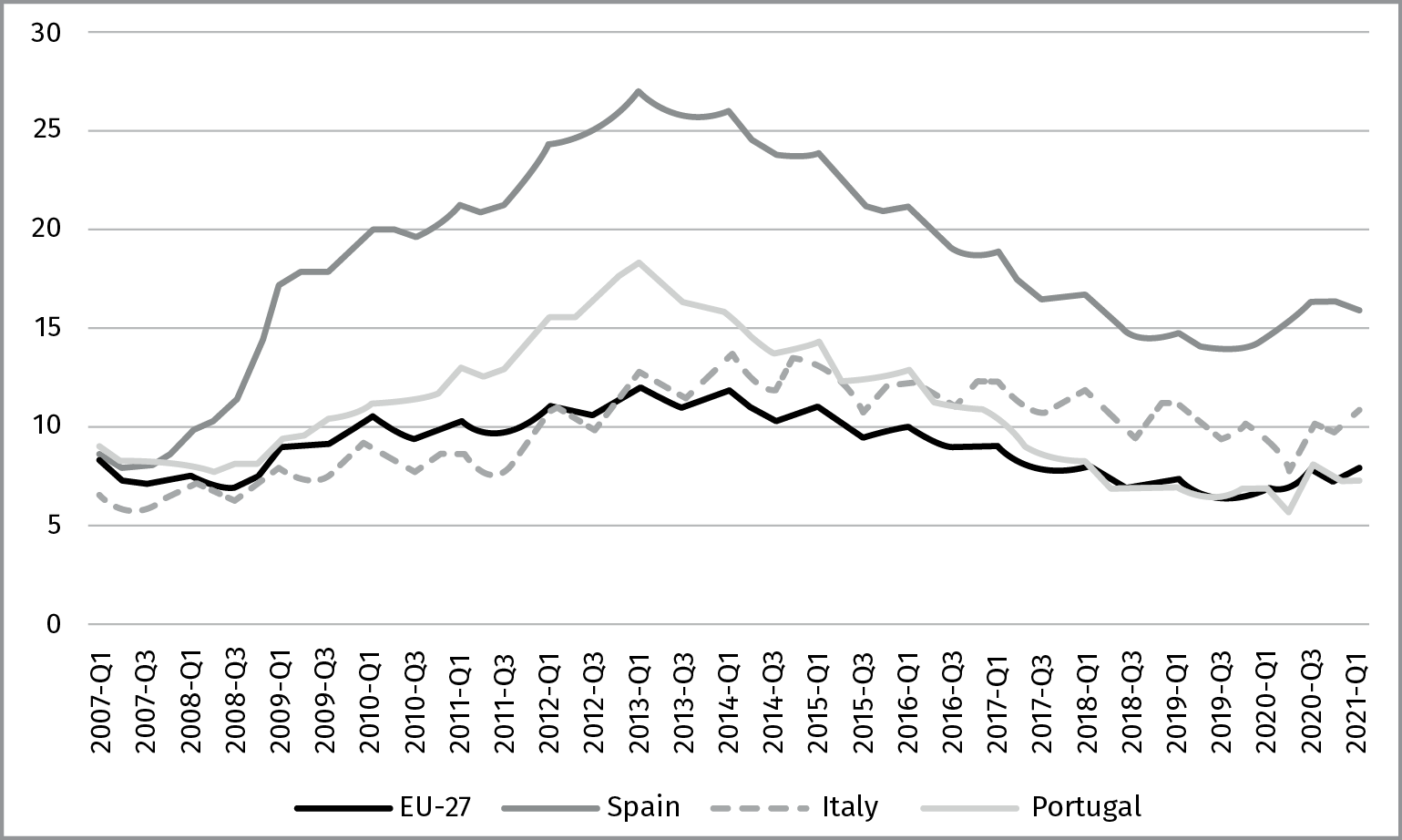
Source: Prepared by the authors with quarterly data from
EU-LFS (Eurostat) (1)EU-27 excluding the UK.
The evolution of unemployment suggests that the measures introduced in the three countries have
been efficient in terms of protecting employment during the pandemic —see OECD (2020a, Chap. 1).
Portugal reorganised its existing programmes, while Italy introduced an Emergency Basic Income (REM)
unconditional to seeking employment. Spain expanded its short-time work schemes (ERTEs in Spanish) and introduced specific actions to protect the
self-employed and other non-standard workers (Moreira et al., 2021). Apart from these strategies, these Southern
European countries also expanded their social protection networks for the unemployed and families with care
duties, although this has not prevented a deepening of the gender gap in the labour market and in homes (Blaskó et al., 2020; OECD, 2020d; Salido, 2021).
As a result, we believe that the image in Figure 1 showing the evolution of un-employment during the pandemic
does not adequately reflect the actual impact of the COVID-19 crisis on the labour market in these three
countries. In our opinion, this is due to two interrelated reasons. First, the indicator used –the official
unemployment rate– does not make the consequences of the pandemic sufficiently visible, as a share of the
work lost is diverted to inactivity and underemployment. Secondly, the general figure might hide the very
unequal impact on different populations, thus obscuring the actual brunt on groups that have traditionally
experienced precarious work and that are more likely to be unemployed.
Regarding the first point, authors such as Ruesga & Viñas (2021) have studied how unemployment statistics
in Europe do not reflect the magnitude of the pandemic’s impact, as the official rate is based on ILO
criteria and does not consider a large share of the unemployed. Following these criteria, official
institutions such as European Statistical Office [Eurostat] have tried to partially remedy this problem by
introducing the necessary changes to obtain a new indicator that accounts for “labour market slack”, that
is, the entire unsatisfied demand for employment (Eurostat, 2020a; 2020b). Regarding the second point, economic crises do not affect
all individuals in the same way. The literature suggests that women, young people and migrants are often the
groups most deeply affected by recessions –we will be focusing our analysis on these three groups, as they
are especially vulnerable. These populations tend to be employed in
occupations that are not suitable for teleworking (blue-collar jobs, unskilled labour, etc.) and they show
higher vulnerability to economic instability, as previously reported (Fernández Esquinas, 2020).
In this context, this paper compares the labour market performance of vulnerable populations in
three South European countries with a cross-analysis of data over time, through the design and
implementation of an alternative and expanded unemployment indicator as a labour market analysis tool.
Through this new rate, we try to show the true evolution of unemployment in Portugal, Italy and Spain
between 2007 and 2020 Thus, our article reflects upon the concepts of standard unemployment and hidden
unemployment and how they both relate to economic crises, particularly within the Southern European context.
We also include a section that discusses our methodology, including the data sources used, and we describe
the development process of our extended unemployment rate. We then move to a comparison of the significant
figures for official unemployment and extended unemployment rates in the three sample countries. Finally, we
draw some conclusions about our analysis and provide some reflections for future study.
Analysing unemployment in contexts of
crisis: main challenges and limitations
Insufficient employment is an integral part of the capitalist economy. Job shortages seem to be
one of the most important concerns of citizens and governments, especially in the countries most widely
affected by the scourge of unemployment. This interest justifies the fact that, despite the increased
displacement of official focus towards employment (Brandolini & Viviano, 2018, p. 2), unemployment is still
constantly monitored in labour statistics. Likewise, as labour markets become more complex, the number of
researchers trying to understand the way socio-economic processes and contexts influence different labour
market situations has increased, as well as their interest in the mechanisms that determine unemployment in
different scenarios (Baum and Mitchel,
2010). A large share of the existing literature has been characterised by an essentially
positivist approach, as it has formulated the concept of unemployment using administrative registers and
other secondary data sources (Baum and
Mitchel, 2010). From this perspective, unemployment has often been understood as a
general situation outside of productive employment: a problematic space that needs to be managed (Gerrard & Watson, 2021).
However, while the literature has focused on the division between employment and unemployment,
citizens seem to strive to understand the labour market in a more comprehensive fashion. Thus, a step beyond
official statistics is needed to respond to different situations in daily life. This excessive focus on the
economic viewpoint by a large share of researchers has somehow marginalised the social aspects linked to
unemployment (García Pérez & Villar,
2020). Thus, studies such as Sanchis (2016) show the mismatch between how the unemployed perceive
themselves and how they are classified in official statistics. We therefore can state that, in trying to
represent the great diversity of outlooks around unemployment at present, a mere division between labour and
its absence is not enough, as the limits between both spheres are becoming more fluid and blurred in global
and transnational contexts (Beck,
1992).
This fact is of special relevance during economic crises, as they represent scenarios
characterised by both volatility and uncertainty. Due to their vast complexity, these periods and their
aftermaths have been defined as a central axis in the field of Social Sciences (Hensvik et al., 2021). Many
studies have therefore been launched around the relationship between economic crises and unemployment,
especially after the Great Recession (Pohlig, 2021; Garofalo et al., 2018; Heidenreich, 2016). This was
a recession that caused the worst economic upheaval since 1930 in the OECD (Keeley & Love, 2010),
especially in the South of Europe (Moreira et al., 2021; Barroso, 2017). Italy, Portugal and Spain showed sharp drops in
their GDPs, strong increases in unemployment and generalised loses of household income and quality of life
(Moreira et al, 2015).
Currently, the crisis scenario derived from the COVID-19 pandemic has once again shone a
spotlight on the relationship between recession and unemployment, although its health characteristics will
make it unprecedented (Molina-Villacís
et al., 2020). The extraordinary measures implemented by governments will negatively
affect economic activity and the labour markets in many countries. In spite of the schemes implemented to
safeguard jobs and salaries, the measures leading to preventing infections are expected to generate
unemployment at levels similar to or higher than those experienced during the Great Recession (Alon et al., 2020; Giupponi & Landais,
2020).
Although this is a recent phenomenon, the impact of the pandemic is so significant that several
studies are trying to unravel its consequences on the labour market in general and on unemployment in
particular (Alon et al.,
2020). Those studies highlight how the restrictions related to lockdowns have led to
unemployment (Paterson-Young,
2021) and how social isolation has been damaging for the quality of life and wellbeing of
individuals (Sibley et al.,
2020). This wide scientific production predicts that the Italian, Portuguese and Spanish
economies will once again become the hardest hit, as these are also the countries that have experienced the
highest number of infections and deaths (Moreira et al., 2021). Furthermore, several of these studies have
focused on some vulnerable groups who, like women, young people and migrants, are more widely exposed to
unemployment (Blundell et al.,
2020; ILO,
2021; Salido,
2021).
The inadequacy of official unemployment statistics to account for the effects of the pandemic
becomes more evident when trying to analyse the impact of the COVID-19 crisis on these populations. There is
a large number of people who would like to and try to work, but they are not listed in the official
unemployment figures. Following completely plausible scenarios, these people should be considered as part of
the unemployed population. Not doing so implies refusing to acknowledge the magnitude of the actual losses
in production capacity, national income and, in a nutshell, the capacity for growth of a particular economy
(Mitchell & Muysken,
2008). These, among others, are the reasons why the conventional unemployment rate needs
to be replaced by an indicator that more accurately measures the extent of unemployment –a need that has
become more pressing in the context of the pandemic (Ruesga & Viñas, 2021).
Since the 1970s, the literature has warned that a section of the unemployed, as well as some
forms of employment, are invisible in official statistics. Although we are far from having a widely accepted
methodology to measure hidden unemployment, the need for some homogeneous criteria that allow for an
objective reading has become evident. In the literature, notable works include: at the supranational level,
Green (1999) and Holst & Spieß (2002); in
Australia, Barrett (2004), Mitchell (2007), Baum & Mitchell (2010)
and Kong (2011); in the
United Kingdom, Beatty & Fothergill
(2002, 2004); in the United States and Canada, Partridge (2001); in Italy,
Brandolini et al. (2006); in
Spain, Sanchis (2016), Sanchis & Simó (2014)
and García-Pérez & Villar
(2020); and, in Germany, Holst & Schupp (2000) and Provenzano (2017).
Therefore, our study sees the pandemic as an urgent trigger for implementing an alternative way
of measuring unemployment though the expanded unemployment indicator, which accounts for job shortages,
especially for vulnerable groups. We need to bring those individuals who remain on the dark side of
traditional unemployment measurements into the spotlight, so that they are no longer invisible to
conventional statistics. Their exclusion from the unemployed means an underestimation of the general impact
of unemployment and therefore hinders the introduction of specific measures to support them in accessing the
labour market.
Methods
In order to prepare and assess our proposal to make hidden unemployment rates operational, we
used an anonymised subsample from the EU-LFS microdata from Italy, Portugal and Spain. Through these
datasets we analysed the labour markets of those three countries from 2007, the year prior to the start of
the Great Recession, to 2020, the final year of which microdata was available. As the EU-LFS follow ILO
criteria, the outcomes for the different countries are fully comparable. The calculations are restricted to
a selection of the potential labour force (15-64 years old) to avoid some biases introduced when considering
older individuals. Our main variable is the extended unemployment rate, which we developed by reorganising
the labour status to reclassify as unemployed those people formerly hidden by official definitions of
involuntary underemployment or inactivity.
As we have already mentioned, we focused mainly on three vulnerable groups: young people,
migrants and women. However, we also expanded the age limit of the first group to adjust it to countries
where young people leave their family homes late, thus leaving the group of adults (30-49 years old) and the
elderly (50-64 years old) as comparative references. In addition, the EU-LFS shows some limitations for
understanding the conditions of migrants. In the first place, the characteristics of the sample design lead
to the exclusion of those who do not reside in private homes (or hotel accommodations on a permanent basis).
Besides, it is important to consider the effect caused by the limited knowledge of the language in which the
interview is conducted. In addition, in Spain, interviews are not carried out with foreign nationals who
intend to reside in the country for less than one year. Although weighting makes it possible to correct the
under-representation caused by the latter issue, it will be necessary to take it into consideration.
Conventional unemployment indicators
and their alternatives
Following the initial efforts to use administrative registers to quantify unemployment, the use
of labour force surveys has become widespread, and they are currently considered the most adequate method of
measurement. Likewise, an operative unemployment definition was developed for people between 15 and 74 years
of age who fulfil three simultaneous conditions (Eurostat, 2020c): (1) lacking employment in the terms described
below; (2) being available to work in the 15 days after the interview and (3) having actively sought work
during the past four weeks.
Despite agreement about its origins, this definition has been the subject of harsh and repeated
criticism.
Without ignoring the advantages of the conventional rate as a standardised measure of unemployment, most of
the critiques consider it an inadequate, or at least insufficient, indicator of the real gap between the
amount of working time offered by the labour force and that demanded by employers. These limitations are
seen in the recommendations issued by the EU statistics agency to improve the adaptation of the LFS to
national contexts during the pandemic. In particular, they suggested going beyond the widespread use of the
standard unemployment rate, specifying the labour situations included under the category of inactivity and
introducing a new comprehensive indicator that accounts for “labour market slack” (Eurostat, 2020a).
In response to these considerations, this article develops an alternative indicator
incorporating a wider analytical and methodological perspective to understand and quantify unemployment.
Amongst other things, our rate tries to correct the usual gender blindness of official statistics that, as
Carrasco & Mayordomo (1999, p.
134) state, rely exclusively on “a model of male employment”. In this way, we also set
ourselves apart from other attempts to measure hidden unemployment that lack sensitivity in terms of the
effects that gender has on the way women and men relate to the labour market. For example, these bias leads
many to understand part-time employment or inactivity due to care work duties as a voluntary decision.
Figure 2
summarises the process followed to operationalize extended unemployment. As we may see, the process by
recovering for hidden unemployment part of the group of involuntary underemployment and part of the
potential active labour force that the conventional definition categorises under employment and inactivity,
respectively. For the first group, we use a definition of involuntary underemployment particularly
restricted to two strict conditions. First, the usual working time must be below 21 hours per week and 50%
of the desired working time in order to exclude those who just want a working day that is slightly longer
than the current one, or those who are already working almost full-time. Second, apart from wanting to work
longer hours, they must be available (or be tied to their current job under the period of notice), and their
current timetable must be against the person’s free will, i.e., not a genuine preference. Convention
establishes that this last aspect is fulfilled when part-time work is performed because no full-time
employment was found (involuntary underemployment in a strict sense).
However, this condition is also met if they work just a few hours to cover the basic needs of other people
in their household (involuntary unemployment due to family or care
responsibilities).
Regarding official inactivity, we strongly recommend considering that the job-seeking behaviour
and the availability to work of an individual can be hindered by reasons that have nothing to do with the
person’s willingness. In general (Mitchell, 2007; Sanchis, 2016; Baum and Mitchell, 2010), this happens when a person is available to
start a new job but does not seek employment because they do not trust their own capacity to obtain it
(discouraged workers). We would also add the case of those who are
affected by a temporary suspension of employment (available potential
jobseekers excluded for temporary layoffs) and the case of workers whose care work or domestic
duties also prevent them from seeking employment (available potential
jobseekers excluded for family or care responsibilities). From a theoretical point of view, the
inclusion of both subgroups in hidden unemployment is based on two assumptions. First, their willingness to
find a job is proven when they claim that they are available to accept a job immediately. Second, this
predisposition suggests that they would actively seek employment if the structural conditions improved,
i.e., if the labour market conditions or the involvement of men and institutions in care work and domestic
duties materialised.
Following a similar rationale, we also classify under hidden unemployment those jobseekers who
are not immediately available to work in the short-term due to family duties (unavailable jobseekers due to family responsibilities). At this point, we
highlight that the question in the EU-LFS survey used to probe the reasons for unavailability to work does
not include care work as a reason, unfortunately. The pioneering (as far as we know) definition of this
specific subgroup responds to the belief that two weeks can be insufficient to reorganise any kind of care
infrastructure for dependent persons (Richardson, 2009; ILO, 2016). Finally, as we have shown, the hidden unemployment
figures obtained are added to the official unemployment rate, thus leading to our extended unemployment
rate, which, along with the remaining active population (active in a strict
sense) and inactive population (inactive in a strict sense)
produces a triple classification in terms of the labour status.
Figure 2.
Reconstruction of the Labour Status Including Extended Unemployment.
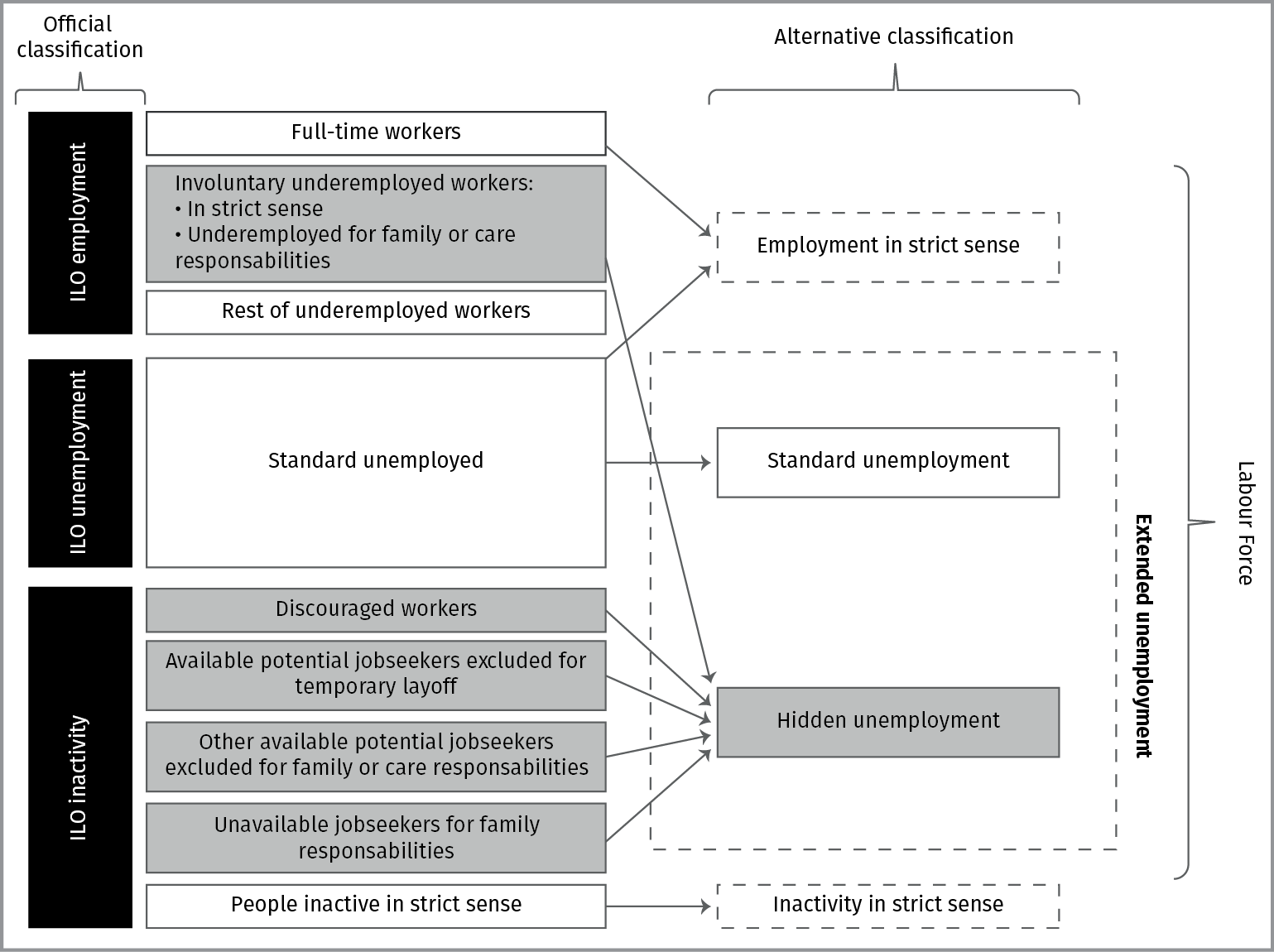
Source: Prepared by the authors.
In the face of increased infections and deaths caused by the COVID-19 virus, the three
governments in question declared a state of emergency in March 2020. Amongst other measures, this decision
implied the complete halting of all recreational, cultural, sports and commercial activities, as well as
hospitality and educational activities that implied face-to-face interactions and close personal contact.
Without a doubt, these restrictions on mobility and partial closures of all business activities are expected
to distort the snapshot of the labour market with artificial transfers between unemployment, inactivity and
employment. Thus, the requirement of seeking employment could not be easily fulfilled by those who wanted to
stop being inactive or by those who wanted to replace their recently lost jobs; they would therefore be
listed as inactive rather than as unemployed. Besides, the person’s own ill health or caring for dependent
individuals would become a more relevant reason for not seeking employment or for their unavailability. All
this was expected to translate into a higher hidden unemployment rate, as well as into a higher official
unemployment rate. In the face of increased infections and deaths caused by the COVID-19 virus, the three
governments in question declared a state of emergency in March 2020. Amongst other measures, this decision
implied the complete halting of all recreational, cultural, sports and commercial activities, as well as
hospitality and educational activities that implied face-to-face interactions and close personal contact.
Without a doubt, these restrictions on mobility and partial closures of all business activities are expected
to distort the snapshot of the labour market with artificial transfers between unemployment, inactivity and
employment. Thus, the requirement of seeking employment could not be easily fulfilled by those who wanted to
stop being inactive or by those who wanted to replace their recently lost jobs; they would therefore be
listed as inactive rather than as unemployed. Besides, the person’s own ill health or caring for dependent
individuals would become a more relevant reason for not seeking employment or for their unavailability. All
this was expected to translate into a higher hidden unemployment rate, as well as into a higher official
unemployment rate.
Results
This section uses the official unemployment rate (according to ILO criteria) and our extended
unemployment rate to compare the relevance and the evolution of unemployment in Spain, Italy and Portugal.
Data from 2007 to 2020 are first analysed at the aggregate level, and then focus on specific rates by sex,
age and country of birth. This simple snapshot helps us assess the adequacy of our indicator in a context
marked by the impact of the COVID-19 pandemic, extracting preliminary trends that might be shared by the
other Southern European countries.
Until the initial outbreak of the pandemic, Spain, Portugal, and Italy had shown positive
developments in their unemployment rates. From the end of the Great Recession, the three economies had
experienced a period of recovery and economic growth, which was more remarkable in Spain and Portugal than
in Italy (Moreira et al.,
2021). These positive trends in unemployment are in contrast with the previous situation,
marked by the major economic and financial crisis that began in 2008 and the crisis triggered by COVID-19 in
2020.
As we can see on the left-hand side of Figure 3, the three countries showed very similar levels of standard
unemployment in the year prior to the onset of the 2008 crisis, although Italy was one step below the two
Iberian countries. It may also be observed that from 2008 onward, unemployment took a dramatic upward turn
in the three countries. Although this growth was more intense in Spain and Portugal, recovery kicked in
later and more slowly in Italy. Finally, the 2020 data suggests that, although the pandemic crisis has hit
the three economies equally, they have experienced it unevenly. Thus, while in 2020, there has been a new
upturn in official unemployment in Portugal and, above all, in Spain, Italian unemployment has maintained
the declining trend that had been reflected during the previous five-year period.
However, taking into account the data on extended unemployment leads to a different reading of
what has happened in these three labour markets since 2007. To begin with, the situation prior to the onset
of the Great Recession was much worse in Italy than the official figures suggested. Thus, adding hidden
unemployment rates to those measured by the official definition of standard unemployment belies the fact
that the transalpine country started in a worse position than Portugal and Spain. In this way, the
estimation of the extended unemployment rate places Italy closer to Spain and even above Portugal during
almost the entire period analysed. Although unemployment rose more sharply in the Iberian countries during
the Great Recession, it fell much more slowly in Italy. In contrast, the 2020 data confirm that Italian
unemployment did not rise during the pandemic crisis, instead maintaining the downward trend that it had
been registering in previous years. This contrasts with what has happened in Spain and, above all, Portugal,
where unemployment has risen, especially if we measure it with the extended unemployment indicator.
To summarize, and as Figure
4 shows, despite the fact that using the extended unemployment rate elevates the extent
of unemployment in the three countries, this effect is more significant in Italy, where unemployment
increases 8.3 percentage points on average when this rate is used (versus 5.7 pp in Spain and 3.4 pp in
Portugal). A disaggregated analysis shows that this is due to the high number of individuals who are not
actively seeking employment due to discouragement —something Sorrentino (1993, pp. 15-16) already mentioned— or to family duties
or care work in Italy.
While the data above confirms that hidden unemployment is far higher in the Italian economy and
that the standard rate does not adequately translate the magnitude of the comprehensive labour market slack
in this country, we still had to test whether our predictions are confirmed for vulnerable groups. Our
assumption was that the gap between the official figures and the expanded measurement is bound to be higher
when gender, country of birth and age of the labour force is taken into consideration. This is shown in Figure 5, which introduces a
comparison between the official and extended rates for the different population subgroups for the sample
period. We can see how young people, migrants and women are, always in that order, the groups most widely
affected by unemployment. Although this is something that is already well-known, the relevant point here is
that the difference is substantially enlarged when it is measured with more flexible criteria Likewise, the
figures below show that the gap between both indicators is always far bigger in Italy than in Spain and
Portugal.
First, the extended rate better illustrates the high vulnerability of young people in the three
countries studied. Regardless of the geographical context and indicator used, this group always experiences
higher unemployment and is further from their reference groups. For example, in Italy, there is a difference
of almost 20 percentage points against the 50-64 age group. Next, migrants are more exposed to precarious
work and unemployment than natives. Studies such as Martín Artiles et al. (2011), confirm migrants’ higher presence in
seasonal work and their vulnerability in the face of general changes in the economy. This situation of
disadvantage is even more obvious with our alternative indicator, as it increases the gap between locals and
migrants in all the countries studied.
Lastly, we see that the distance between both rates is always lower for men than for women,
especially in Italy. This means that the conventional rate softens the reported disadvantages of women in
the labour market: the gender gap is multiplied by four when our indicator is used. This confirms that women
hold a weaker position in the labour market in the South of Europe (Esping-Andersen, 1999),
which is further aggravated during a recession (Richardson, 2009). However, the change in magnitude in the
unemployment gender gap with our rate confirms that, as we predicted earlier, official statistics exhibit
gender bias. In conclusion, while the three vulnerable groups identified have a disadvantageous position in
the labour market regardless of the rate used to measure unemployment, our estimates show that they are
especially exposed to hidden unemployment.
Below, we adopt a longitudinal perspective to test the benefits of our unemployment rate by
analysing the most vulnerable groups throughout the economic cycle and, very particularly, during the early
stages of the pandemic crisis. In this sense, the data shows that our new definition increases the size of
unemployment in all three countries and that this is valid for the entire period in question and for the
three vulnerable groups considered. Although the increase is especially noticeable for women (especially in
Italy) and for migrants, its effect on Spanish and Portuguese youth is somewhat lower than the effect it has
had on older workers (50-64 years old). This is due to the fact that older workers suffer particularly from
the scourge of unemployment in both Iberian countries (Eurofound, 2018). The result is that the gaps by gender, age, or
country of origin widen when we measure unemployment with more flexible criteria, yet again confirming the
suitability of our operationalization proposal to capture the hidden unemployment that occurs among the most
vulnerable groups in the labour market.
Figure 3.
Standard and Extended Unemployment Rates in Spain, Italy and Portugal (2007-2020).
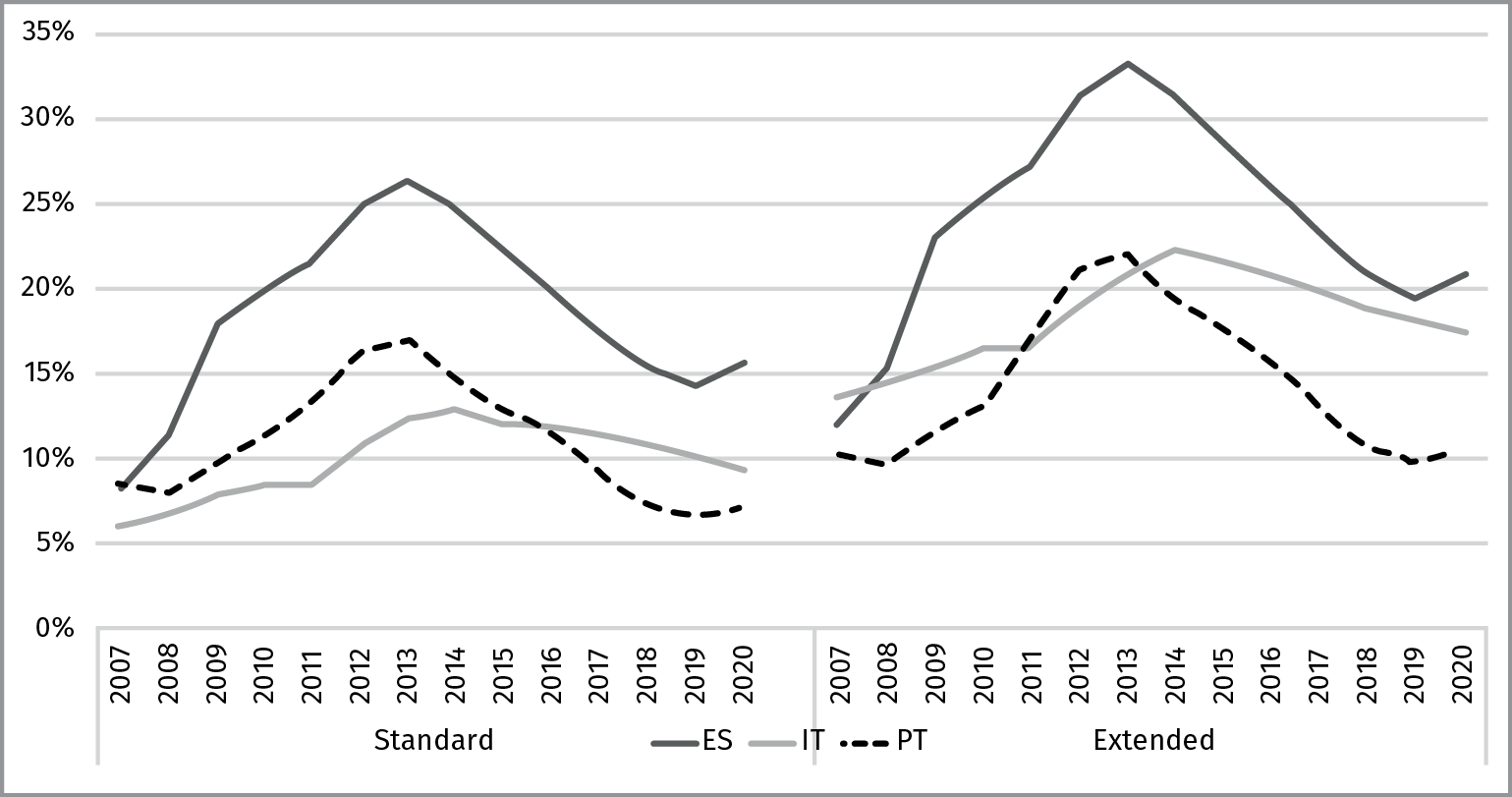
Source: Prepared by the authors using the Labour Force
Survey (LFS).
Figure 4.
Standard and Extended Unemployment Rates in Spain, Italy and Portugal (average 2007-2020).
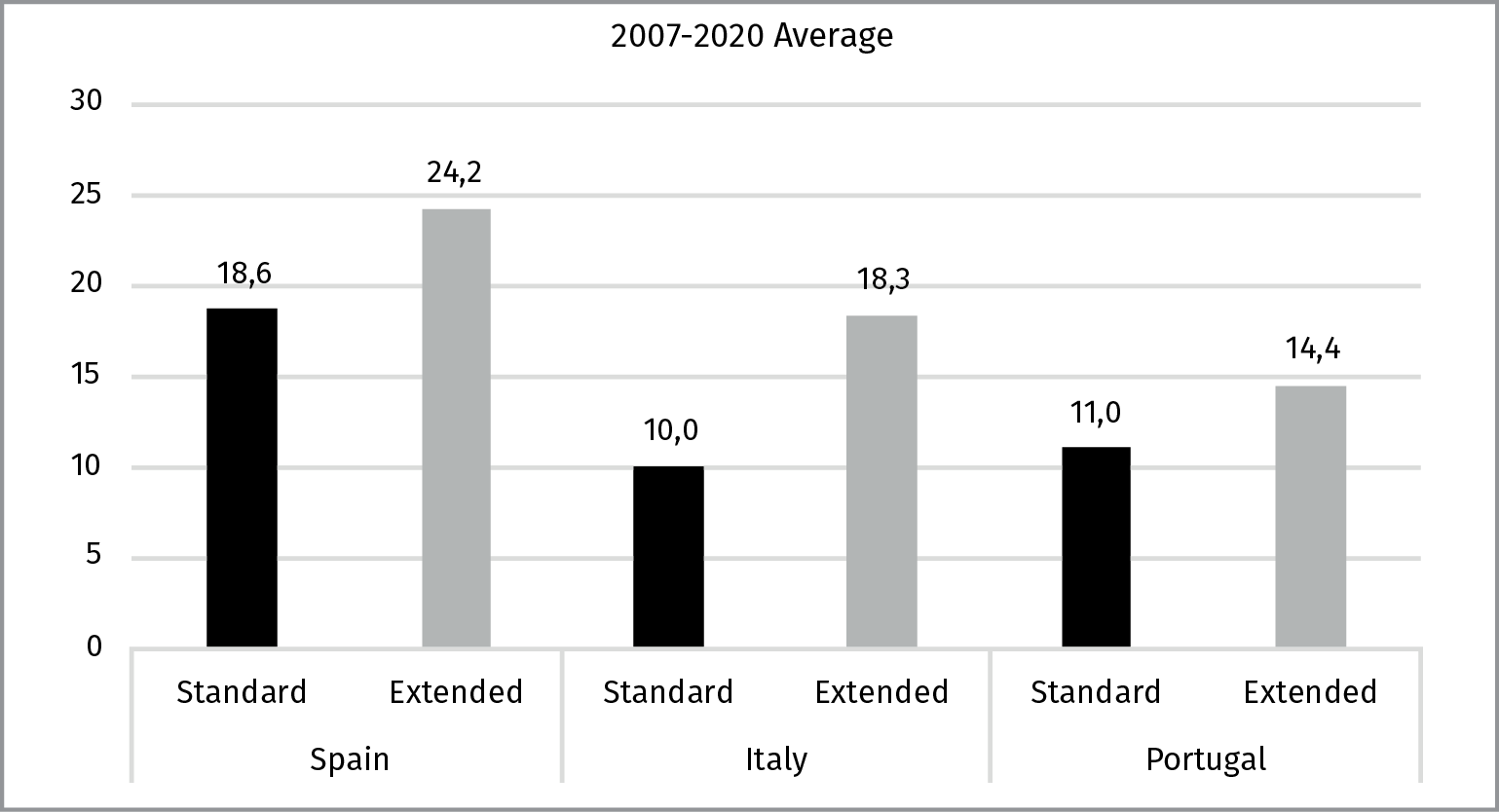
Source: Prepared by the authors using the Labour Force
Survey (LFS).
Figure 5.
Standard and Extended Unemployment Rates by Sex, Age and Country of Birth in Spain, Italy and Portugal
(2007-2020).
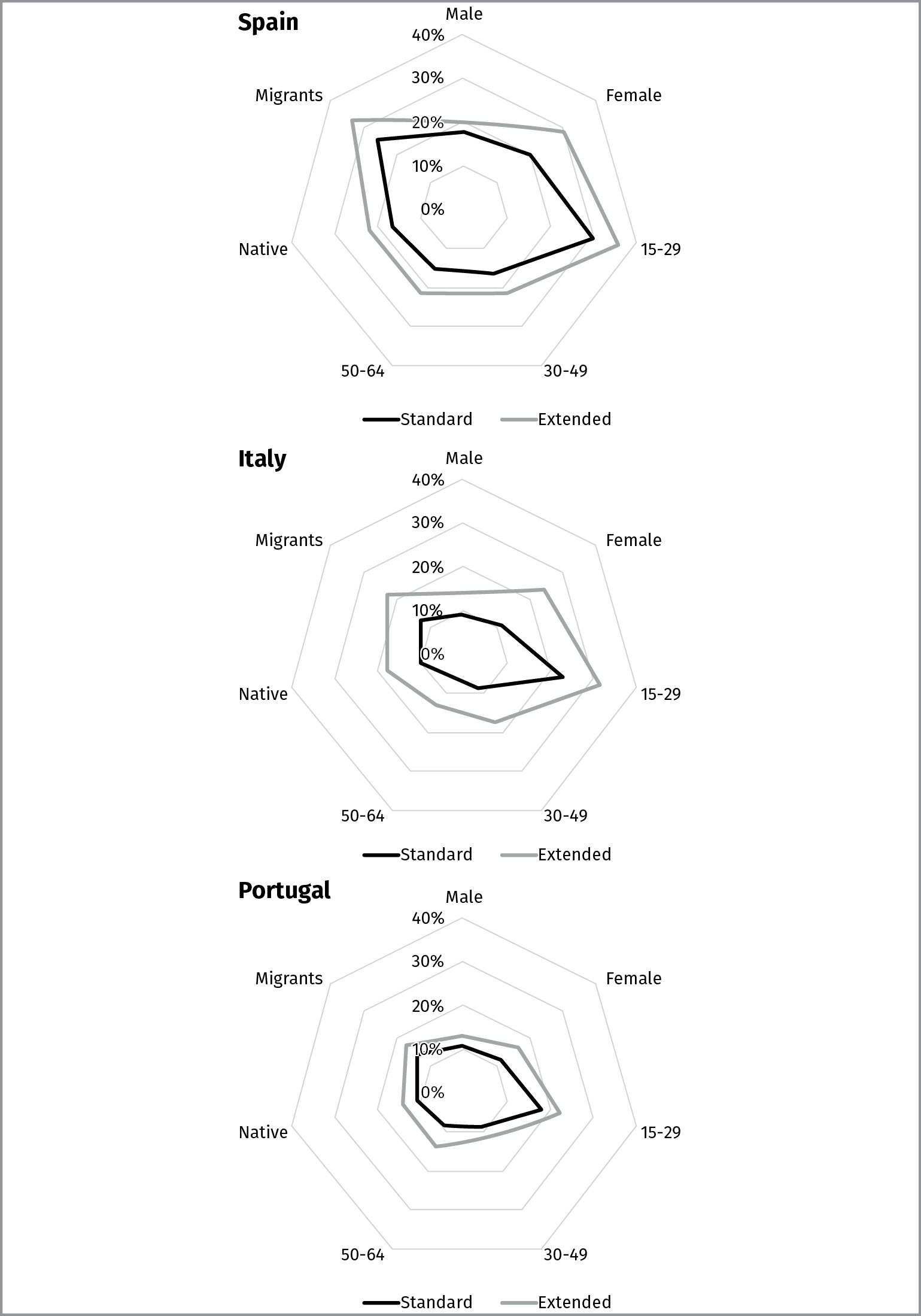
Source: Prepared by the authors using the Labour Force
Survey (LFS).
Although in general terms the extended unemployment rate follows a trend similar to that of the
conventional rate, there are notable differences in the pace and intensity with which the changes occur.
This suggests that vulnerable groups show different degrees of sensitivity to the economic cycle.
The results presented in Figure 6 emphasize how young people are the group most deeply
affected by economic cycles, thus reproducing the trends analysed for the Southern European Countries for
the period 2007-2020. This is due to the fact that the most widely affected sectors during lockdown
(tourism, commerce, etc.) have a large proportion of young workers. This group is characterised by lower
qualifications and by the serious difficulties they find in accessing higher-status and higher- paying jobs
–precisely the jobs that were retained thanks to, amongst other things, telework.
Secondly, similar to the case of young people, migrants also suffer more from the devastating
effects of the crisis. Moreover, just as the data for the period before and during the pandemic showed,
unemployment figures for migrants are far higher than those for native populations in all three countries
(see Figure 7). The
literature has widely hinted at the higher risk of unemployment experienced by the migrant population living
in Southern Europe (Bernardi et al.,
2011). This labour group is characterised by high seasonality, precariousness and low
skills. Therefore, in the framework of the COVID-19 crisis, migrants have hardly been targeted by
unemployment contention measures. Few of these jobs they hold are compatible with online work, which is
usually linked to higher qualifications. This exposes the group to higher unemployment rates.
In addition, if we look at the evolution of the official and extended rates of unemployment for
migrants, we see how the differences between the two rates are accentuated at the beginning of the pandemic
period. This is due to the impossibility of them immediately joining the labour market because they are more
discouraged than the local population in the face of a crisis, or due to their poor working prospects, among
other reasons. Our findings bring to light the invisible position that many migrants have faced in the
occupational sector.
The situation in Italy with respect to its foreign-born population is particularly
illustrative. According to the standard definition, migrant unemployment would have fallen by half a
percentage point between 2019 and 2020, when in fact it has risen by almost a full percentage point if
hidden unemployment is included. In short, our estimates confirm that the migrant labour force, in addition
to having played a crucial role in the fight against the pandemic due to their high representation in some
essential occupations (OECD,
2020c), has also suffered a large part of the unemployment caused by COVID-19 (OECD, 2020e).
Women are widely present not only in the jobs most affected by virus contention measures, but
also in the jobs considered to be essential: namely, health, industry and food (OECD, 2020d). Additionally,
during the pandemic, care work and the work-life balance were brought under the spotlight, and these are
responsibilities shouldered mainly by women. This makes seeking employment difficult, as well as making many
women’s availability to join the labour market immediately impossible.
Such ambiguity makes it difficult to predict the impact of COVID-19 on female unemployment.
Between 2019 and 2020, the extended unemployment rate rose more for men in Spain and Portugal, which would
confirm the “leveling down” caused by the growth of male unemployment during the recessions (Bettio & Verashchagina,
2013). In Italy, on the other hand, the expanded unemployment rates declined in a very
similar way for both sexes.
Going further back in time to compare the evolution of unemployment for both sexes according to
the official and the extended unemployment rates confirms that, as Richardson (2009, pp. 28-29)
suggests, part of the impact of the recessions on the female labour force is masked by hidden unemployment.
In other words, the official statistics do not truly capture the recessions’ full effects.
Figure 6.
Standard and Extended Unemployment Rates by Age in Spain, Italy and Portugal (2007-2020).
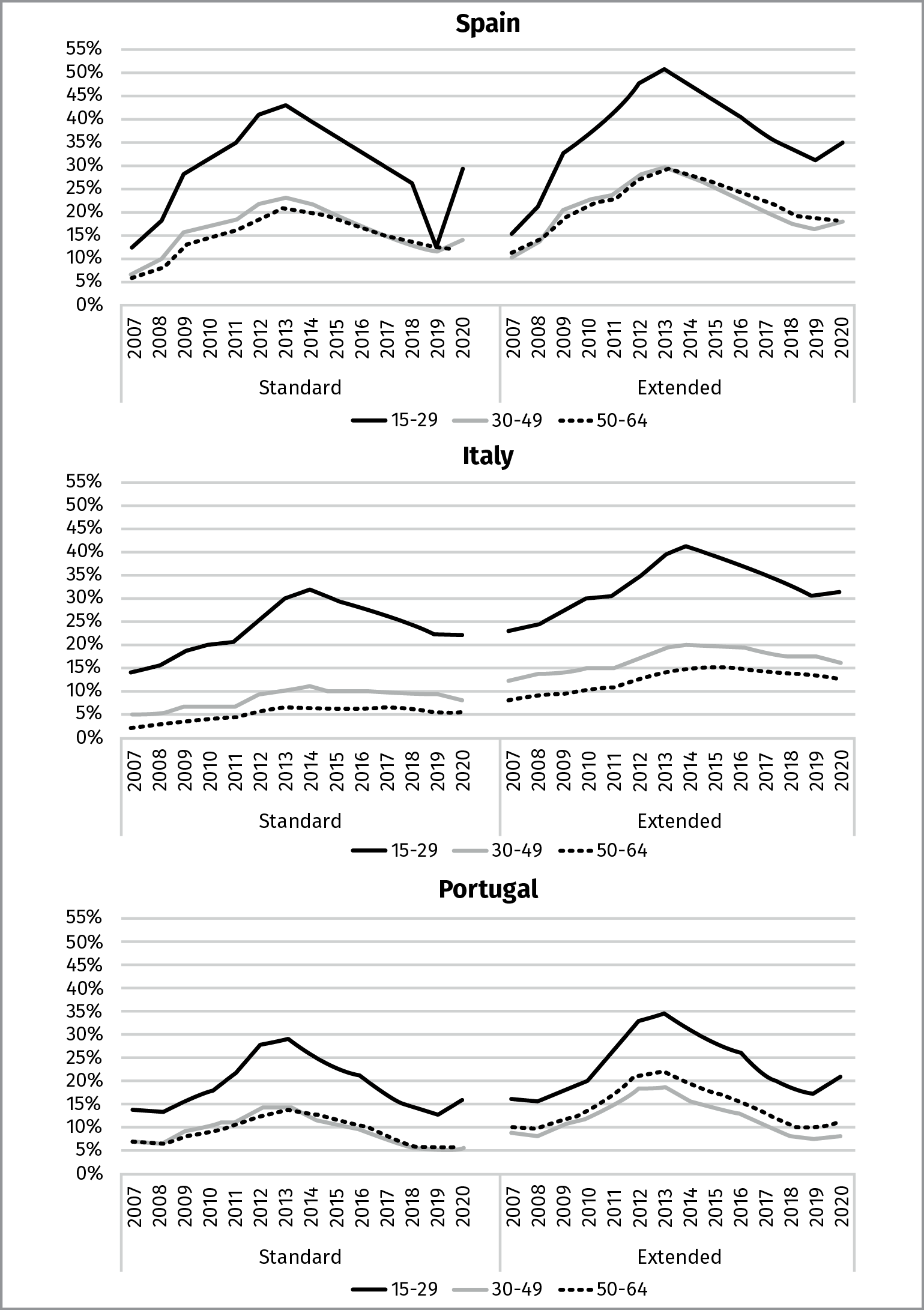
Source: Prepared by the authors using the Labour Force
Survey (LFS).
Figure 7.
Standard and Extended Unemployment Rates by Country of Birth in Spain, Italy and Portugal (2007-2020).
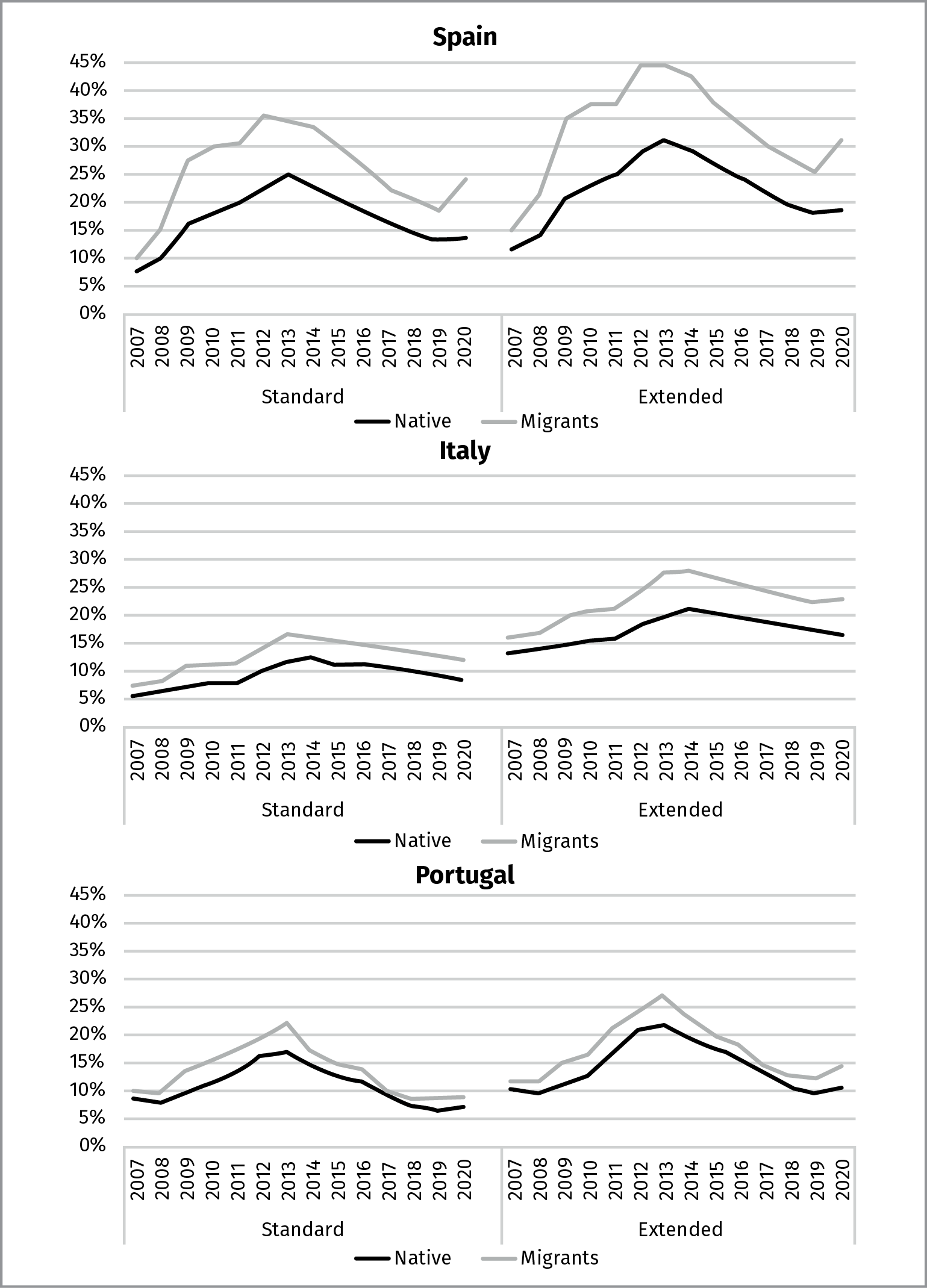
Source: Prepared by the authors using the Labour Force
Survey (LFS).
Hence, our understanding of the functioning of Southern European labour markets is improved by
including hidden unemployment when estimating the true magnitude of unemployment. For example, even though
the official definition implies that the gender unemployment gap narrowed substantially during the Great
Recession, using the extended unemployment rate shows that the gap never falls below three percentage points
in Portugal, seven in Spain, and ten in Italy (see the left-hand side of the Figure 8). Similarly, using
the extended unemployment rate demonstrates that, during economic expansion, the gender gap decreases much
less than is often believed.
Figure 8
Standard and Extended Unemployment Rates by Sex in Spain, Italy and Portugal (2007-2020).
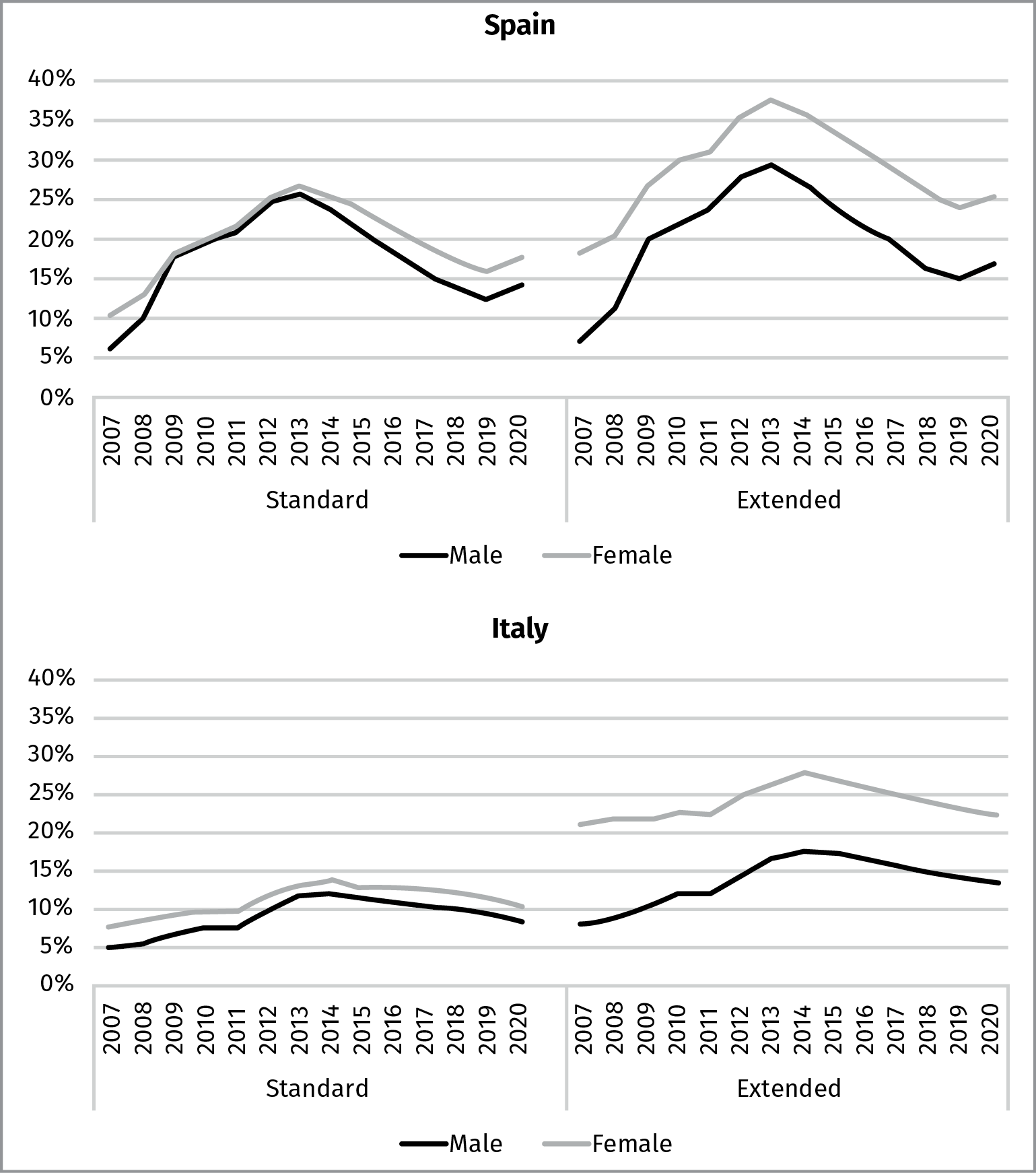
Source: Prepared by the authors using the Labour Force
Survey (LFS).
In summary, using the extended rate allows us to appreciate that the gender gap is larger and
more stable than is usually believed— for example, Azmat et al. (2006). Moreover, this suggests that the unemployment
differential between the two sexes responds more to structural factors than to cyclical factors. This would
explain, in turn, why the pandemic crisis has harmed women’s job opportunities less than those of young
people and migrants in all three countries.

![]()

![]()

![]()







